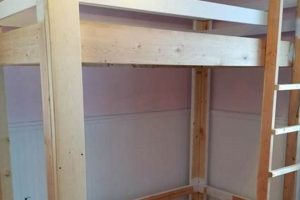Construction of a bedside safety device, undertaken as a personal project, involves the fabrication of a structure designed to prevent falls from a bed. This can include building a rail from wood, metal, or other suitable materials, and attaching it securely to the bed frame. An example would be an individual constructing a wooden rail, following online plans, to assist an elderly relative with mobility issues.
The advantages of crafting such a structure are multifaceted. It provides a cost-effective alternative to purchasing commercially manufactured products, allows for customization to specific bed dimensions and user needs, and offers a sense of accomplishment. Historically, individuals have created customized solutions for safety and comfort within their homes, predating mass-produced alternatives.
The subsequent discussion will delve into material selection, design considerations, construction techniques, and safety guidelines relevant to building a customized bedside safety solution. Specific focus will be given to ensuring structural integrity and secure attachment mechanisms.
Constructing a Bedside Safety Device
The creation of a custom bedside safety device necessitates meticulous planning and execution. The following guidelines are intended to ensure both the functionality and safety of the finished product.
Tip 1: Material Selection: Choose materials based on strength, durability, and non-toxicity. Untreated lumber should be avoided in favor of sealed or painted options to prevent splintering. Steel or aluminum requires proper finishing to prevent rust or sharp edges.
Tip 2: Secure Attachment: The method of securing the rail to the bed frame is paramount. Utilize bolts, clamps, or other fasteners rated for the anticipated load. Ensure the attachment points distribute the force evenly to prevent damage to the bed frame.
Tip 3: Height and Length Determination: Accurately measure the bed height and desired rail length. The rail should extend sufficiently above the mattress to prevent falls, while also allowing for easy ingress and egress from the bed.
Tip 4: Edge Rounding and Smoothing: Sharp edges and corners pose a safety hazard. All edges should be rounded or beveled using appropriate tools. Sand all surfaces to eliminate splinters and roughness.
Tip 5: Weight Testing: Before relying on the rail, subject it to a weight test. Apply a force equivalent to the user’s weight and observe for any signs of instability or failure.
Tip 6: Gap Assessment: Ensure that the gap between the rail and the mattress, as well as any gaps within the rail structure itself, are small enough to prevent entrapment of limbs or other body parts. Consider relevant safety standards for allowable gap sizes.
Tip 7: Regular Inspection: Routinely inspect the rail for loose fasteners, cracks, or other signs of wear and tear. Promptly address any issues to maintain its structural integrity.
Adherence to these guidelines will maximize the safety and effectiveness of a self-made bedside safety device, contributing to a safer sleep environment.
The subsequent section will explore common design flaws and preventative measures to further enhance the safety and longevity of the structure.
1. Material Strength
Material strength constitutes a fundamental consideration in the construction of a bedside safety device. The selection of a material with inadequate strength directly compromises the device’s primary function: preventing falls from the bed. A material’s ability to withstand applied forces, such as the weight of an individual leaning against the rail, without deformation or fracture, is paramount. For example, utilizing thin-walled PVC piping, known for its relative weakness, as the sole structural element of a rail intended for an adult user would present an unacceptable risk of failure. The intended user’s weight and any potential impact forces must be considered when calculating the required material strength.
The cause-and-effect relationship between material strength and device performance is straightforward. Insufficient strength leads to structural failure, increasing the risk of injury. Conversely, selecting a material with appropriate strength ensures the device’s ability to fulfill its intended purpose. A practical illustration involves the use of solid hardwood, such as oak or maple, or appropriately gauged steel tubing for the construction of a robust rail designed for frequent use by an individual with limited mobility. The selection process must also account for environmental factors, such as humidity, which can affect the long-term durability and strength of certain materials, especially wood.
In summary, material strength is an indispensable component of any self-made bedside safety solution. Proper material selection, based on careful consideration of anticipated loads and environmental conditions, is crucial for ensuring the device’s effectiveness and the user’s safety. A failure to adequately address material strength negates the intended benefits of the device, potentially leading to dangerous outcomes. Subsequent sections will delve into specific testing methodologies to assess the suitability of chosen materials.
2. Attachment Security
The stability and efficacy of any bedside safety device are inextricably linked to the security of its attachment mechanism. The method used to affix the rail to the bed frame directly determines its ability to withstand lateral forces and prevent unintended dislodgement. A poorly secured attachment point negates the intended benefits of the rail, rendering it a potential hazard rather than a safety aid. Consider the scenario where a rail, constructed from robust materials, is attached to the bed frame using only lightweight screws and flimsy brackets. Under the force of an individual leaning against it or attempting to use it for support, the attachment points could fail, causing the rail to detach and potentially resulting in a fall. Thus, the robustness of the rail itself is secondary to the integrity of its connection to the bed.
Effective attachment strategies involve distributing the load across multiple points on the bed frame. Utilizing bolts, clamps, or through-bolting methods provides a more secure connection than relying solely on screws. The choice of fastener must be appropriate for the materials being joined; for example, when attaching to a metal bed frame, hardened steel bolts with locking nuts are preferable. The attachment hardware must also be compatible with the design of the bed frame; certain bed frames may require custom-fabricated brackets or adapters to ensure a secure and stable connection. Furthermore, regular inspection of the attachment points is essential to identify and address any signs of loosening or wear before they compromise the stability of the rail. Consider the case of a wooden rail attached to a metal bed frame; differing expansion and contraction rates between the materials can cause the fasteners to loosen over time, necessitating periodic tightening.
In summary, attachment security is a non-negotiable aspect of bedside safety device construction. A structurally sound rail is rendered useless without a reliable and robust attachment mechanism. Proper planning, material selection, and installation techniques are vital to ensuring the device’s long-term stability and the user’s safety. Neglecting attachment security undermines the entire effort, transforming a potentially beneficial device into a significant hazard. The stability test should always be performed after attachment.
3. Height Appropriateness
The dimensional characteristic of height plays a pivotal role in the effective implementation of a bedside safety solution. Height appropriateness, within the context of a fabricated bedside rail, dictates its functionality and contributes directly to user safety. Incorrect height dimensions can render the device ineffective or, conversely, create new hazards.
- Prevention of Falls
The primary objective of a bedside rail is to prevent falls. If the rail is too low, it fails to provide sufficient barrier to deter a user from rolling out of bed. Conversely, if the rail is excessively high, it could impede entry and exit from the bed or create a tripping hazard. An optimal height balances these considerations, offering substantial fall protection without restricting movement unnecessarily. For example, a rail intended for an elderly individual with limited mobility should be high enough to provide a secure barrier but low enough to allow for independent transfers.
- Accessibility and Usability
Height influences the ease with which a user can access and utilize the bed. A rail that is too high can create a barrier, making it difficult to get in or out of bed. Conversely, a rail that is too low may not provide adequate support for individuals who use it to assist with sitting up or repositioning themselves. The rail’s height should be tailored to the user’s physical capabilities and the height of the mattress. For instance, a rail for a child should be lower than one designed for an adult, reflecting their respective heights and mobility levels.
- Entrapment Risk
Inadequate design considerations related to height can inadvertently increase the risk of entrapment. The space between the top of the mattress and the bottom of the rail must be carefully assessed to prevent a user’s head or limbs from becoming trapped. If the rail is positioned too low relative to the mattress, the resulting gap could pose a significant hazard, particularly for individuals with cognitive impairments or mobility limitations. A thorough assessment of potential entrapment zones is essential prior to using the custom-built safety device.
- Compatibility with Bed Type
The height of the bedside rail must be compatible with the specific type of bed on which it will be used. Platform beds, adjustable beds, and standard bed frames each present unique challenges in terms of attachment and height adjustability. A rail designed for a traditional bed frame may be unsuitable for use with an adjustable bed, where the mattress height can vary. Adaptations may be necessary to ensure that the rail remains at an appropriate height regardless of the bed’s configuration.
The considerations outlined underscore the integral link between proper height selection and the overall effectiveness of a constructed bedside safety device. A rail with inappropriate height, even if well-constructed in other aspects, can compromise user safety and negate the intended benefits. Careful assessment of user needs, bed type, and potential hazards is critical to achieving optimal height dimensions.
4. Edge Smoothness
Edge smoothness is a critical safety factor in the construction of any bedside safety device. The absence of sharp edges and corners minimizes the risk of accidental cuts, abrasions, and impacts that could result in injury during use. The integration of edge smoothing techniques directly enhances the safety and usability of the finished product.
- Injury Prevention
The primary role of edge smoothing is to prevent injuries. Sharp edges or pointed corners can cause lacerations or contusions upon contact, particularly during nighttime use when visibility is limited. Rounded or beveled edges reduce the severity of potential impacts and minimize the likelihood of cuts. For example, a bedside rail with square, unsanded corners presents a significantly higher risk of injury than one with smoothly rounded edges.
- User Comfort
Beyond injury prevention, edge smoothness contributes to user comfort. A smooth surface is more pleasant to the touch and reduces the likelihood of skin irritation or discomfort during prolonged contact. This is particularly important for individuals with sensitive skin or those who frequently use the rail for support or assistance. Consider a situation where an individual uses the rail to assist with sitting up; a rough or jagged edge would cause discomfort and potentially discourage its use.
- Material Suitability
The necessity for edge smoothness dictates, in part, the selection of appropriate materials for construction. Certain materials, such as unfinished wood or rough-cut metal, require extensive edge treatment to render them safe for use. Other materials, such as molded plastics with rounded edges, may inherently possess a higher degree of edge smoothness. The material selection process should, therefore, consider the ease with which the edges can be smoothed and the long-term durability of the edge treatment.
- Finishing Techniques
Various finishing techniques can be employed to achieve edge smoothness, including sanding, routing, filing, and the application of edge banding or protective coatings. The choice of technique depends on the material being used and the desired level of smoothness. For example, sanding is commonly used to smooth wooden edges, while filing is more appropriate for metal edges. Protective coatings can provide an additional layer of smoothness and protect the underlying material from damage. Regardless of the technique used, careful attention to detail is essential to ensure that all edges are uniformly smooth and free from defects.
Edge smoothness is not merely an aesthetic consideration; it is an integral component of a safe and functional bedside safety device. The implementation of appropriate edge smoothing techniques minimizes the risk of injury, enhances user comfort, and contributes to the overall quality and usability of the finished product. Disregarding edge smoothness can transform a potentially helpful device into a source of harm.
5. Weight Capacity
Weight capacity constitutes a paramount safety consideration in the construction and implementation of a customized bedside safety device. Its determination directly influences the structural integrity and operational effectiveness of the rail, thereby mitigating potential risks associated with falls. An accurate assessment of the anticipated load is essential to ensure the device’s suitability for its intended user.
- Material Selection and Structural Design
Weight capacity fundamentally dictates the selection of appropriate materials and the design of the rail’s structure. A device intended to support a heavier individual necessitates stronger materials and a more robust design than one designed for a lighter person. For instance, a rail constructed from thin-walled aluminum tubing may be sufficient for a child, but it would be inadequate for an adult with mobility issues. The structural design must also account for concentrated stress points and distribute the load evenly to prevent localized failure.
- Fastener Strength and Attachment Methods
The strength of the fasteners used to attach the rail to the bed frame is directly correlated with the device’s overall weight capacity. Weak or improperly installed fasteners can compromise the integrity of the attachment points, leading to instability and potential detachment under load. The chosen attachment method must also be appropriate for the bed frame material and design. Through-bolting, for example, provides a more secure connection than relying solely on screws, particularly when supporting significant weight.
- Safety Margin and Load Testing
A prudent approach involves incorporating a safety margin into the weight capacity calculation. This provides a buffer against unforeseen loads or stresses that may occur during use. Following construction, load testing should be performed to verify that the rail can safely support the anticipated weight. This can involve applying a static load equivalent to the user’s weight and observing for any signs of deformation or instability. Regular inspections should be conducted to identify any signs of wear or damage that could compromise the device’s weight-bearing capacity.
- User Safety and Risk Mitigation
Exceeding the weight capacity of a bedside safety device poses a direct threat to user safety. Structural failure under load can result in falls, injuries, and even serious harm. Clear and unambiguous labeling of the device’s weight capacity is essential to prevent misuse. Educating users on the importance of adhering to the specified weight limit is also crucial. For example, a rail designed to support only a limited amount of assistance with getting in and out of bed should not be used as a primary support for transferring weight.
In conclusion, weight capacity is an indispensable parameter in the “bed rail diy” process. Consideration of material strength, fastener selection, load testing, and user education are critical to ensure both the efficacy and safety of the end product. Ignoring weight capacity exposes the user to potentially severe risks and undermines the intended purpose of the bedside safety device.
6. Gap Prevention
Gap prevention constitutes a critical design and construction element in any “bed rail diy” project. Gaps created either between the rail and the mattress, the rail and the bed frame, or within the rail’s structure present a significant entrapment hazard. The cause-and-effect relationship is direct: the presence of gaps of specific dimensions can lead to the entrapment of a user’s head, limbs, or torso, resulting in potential injury or even death. The practical significance of understanding and implementing effective gap prevention measures cannot be overstated; it is paramount to ensuring the safety and well-being of the individual using the fabricated rail. A real-life example illustrates the potential danger: if a significant gap exists between the mattress and the rail, an elderly individual with cognitive impairment could attempt to exit the bed, become wedged in the gap, and suffocate.
Effective gap prevention strategies encompass several considerations. First, precise measurements are essential during the design phase to minimize the potential for gap formation. Second, the rail’s construction should incorporate solid panels or closely spaced bars to eliminate internal gaps within the structure. Third, the attachment method should ensure a snug fit between the rail, mattress, and bed frame, preventing any movement that could create or enlarge existing gaps. Regular inspection of the constructed rail is also vital. As mattresses compress or bed frames shift over time, gaps may develop. Routine checks can identify these emerging hazards, allowing for timely adjustments or modifications to maintain safe gap dimensions. Furthermore, adherence to recognized safety standards concerning maximum allowable gap sizes is a crucial component of responsible “bed rail diy” practices. These standards, often established by regulatory bodies or industry organizations, provide specific guidelines for minimizing entrapment risks.
In summary, gap prevention is not merely a supplementary consideration but an indispensable aspect of responsible “bed rail diy”. Its implementation directly mitigates the risk of entrapment-related injuries and fatalities. Challenges in achieving effective gap prevention include accommodating variations in mattress thickness, bed frame designs, and user needs. However, through meticulous planning, precise construction, and diligent monitoring, these challenges can be overcome, resulting in a safe and functional bedside safety device. Ignoring gap prevention, regardless of the rail’s other features, renders the device inherently unsafe and unfit for its intended purpose.
Frequently Asked Questions
This section addresses common inquiries regarding the design, construction, and safety of self-made bedside safety devices.
Question 1: What are the primary safety concerns associated with constructing a bedside safety device?
Key concerns include the potential for structural failure due to inadequate material strength, insecure attachment to the bed frame, inappropriate dimensions leading to falls or entrapment, and the presence of sharp edges or corners that could cause injury.
Question 2: What materials are most suitable for building a robust and reliable bedside safety device?
Appropriate materials include hardwoods such as oak or maple, steel tubing of sufficient gauge, and durable plastics specifically designed for structural applications. Material selection should be based on the anticipated load and environmental conditions.
Question 3: How can secure attachment to the bed frame be ensured?
Secure attachment necessitates the use of robust fasteners, such as bolts with locking nuts, clamps designed for load-bearing applications, or through-bolting methods where appropriate. The chosen attachment method must be compatible with the bed frame material and distribute the load evenly to prevent localized stress.
Question 4: What dimensions are critical for proper functionality and safety?
Critical dimensions include the rail height above the mattress, the length of the rail, and the size of any gaps within the structure or between the rail and the mattress. These dimensions should be carefully tailored to the user’s physical capabilities and the bed’s specific configuration to prevent falls and entrapment.
Question 5: How can the risk of entrapment be minimized in “bed rail diy” projects?
Entrapment risk mitigation involves eliminating or minimizing gaps within the rail structure and between the rail and the mattress. Gaps should be small enough to prevent the entrapment of a user’s head, limbs, or torso. Adherence to recognized safety standards concerning maximum allowable gap sizes is essential.
Question 6: What testing procedures should be implemented to verify the safety and stability of a self-made bedside safety device?
Testing procedures should include a static load test, where a weight equivalent to the user’s weight is applied to the rail to observe for any signs of deformation or instability. Regular inspections should also be conducted to identify any signs of wear, damage, or loosening of fasteners.
These frequently asked questions highlight the fundamental considerations necessary for the safe and effective construction of a custom bedside safety device. Addressing these concerns is paramount to ensuring user safety and the intended functionality of the device.
The subsequent discussion will explore advanced design techniques and modifications for specific user needs.
Conclusion
The preceding analysis has explored critical aspects of “bed rail diy,” emphasizing the importance of meticulous planning, material selection, and construction techniques. The viability of a self-made bedside safety solution hinges upon adherence to safety standards, accurate dimensional considerations, and rigorous testing protocols. Compromising on any of these elements exposes users to unnecessary risks.
While the prospect of constructing a customized bedside safety device offers potential benefits, individuals must carefully weigh the inherent responsibilities and potential hazards. Prioritizing safety and informed decision-making is paramount. A thoroughly researched, carefully constructed, and regularly inspected bedside safety solution can meaningfully enhance the safety and quality of life for its user. Conversely, a poorly executed attempt can introduce new risks and undermine the intended benefits.







